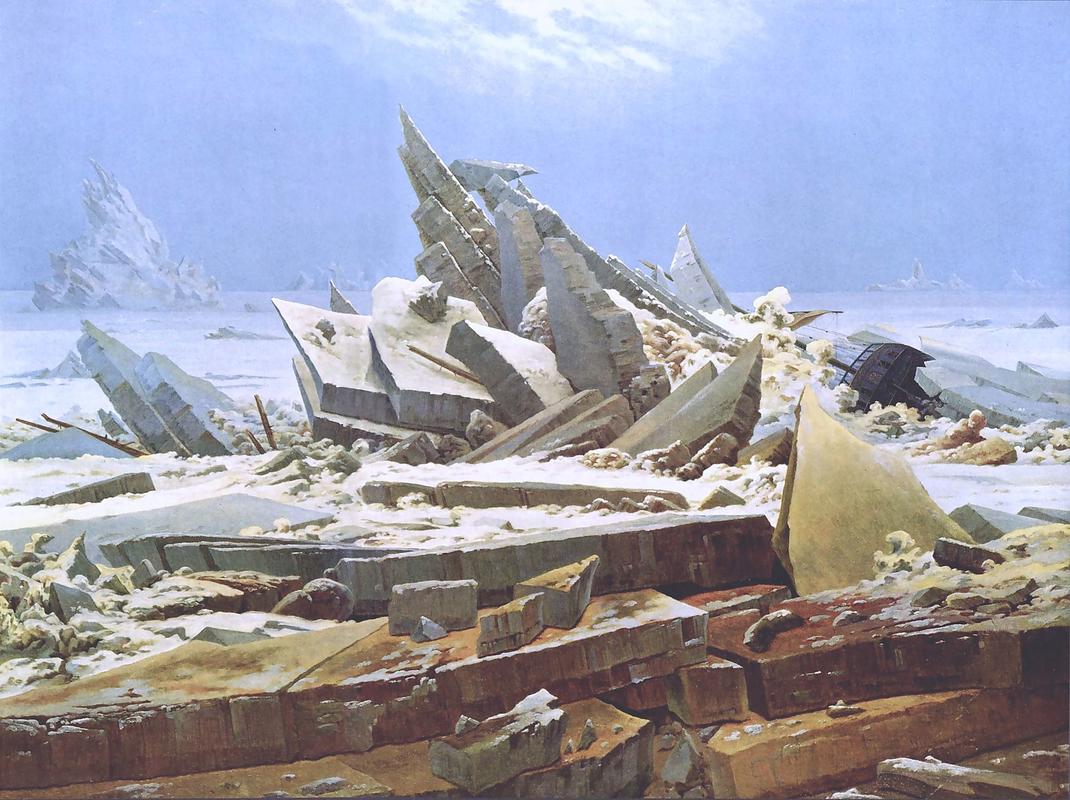More about The Sea of Ice
- All
- Info
- Shop

Sr. Contributor
The Sea of Ice is arguably one of Friedrich’s most emotionally charged and groundbreaking compositions.
It was so radical that, despite being commissioned, it remained unsold until after his death. The painting is also sometimes referred to as The Wreck of Hope, adopting the title from a lost painting of Friedrich’s. The commissioner likely had something much more peaceful in mind, such as Aurora Borealis, and therefore chose to pass on the artwork. However, he was not the only one to give The Sea of Ice a rather cold review - one critic in particular expressed a wish to see the work melt.
Friedrich chose to borrow the name of the gun brig ship HMS Griper for the piece, but the rest was more fueled by the artist’s imagination than the actual adventures of the ship. While it spent lots of time trapped in ice, it did not succumb to a icy tomb as this painting indicates. Friedrich was familiar with the arctic expeditions at the time, but did not witness any scenes firsthand. His preparation for this piece was oil studies of thick blocks of ice. The strong emotion behind this painting was either consciously or unconsciously fueled by the loss of Friedrich’s brother, who drowned in a lake of ice during his childhood.
The HMS Griper was used on multiple Arctic expeditions in the early 19th century starting with William Parry’s 1819 expedition during which it spent roughly ten months trapped in ice. On Parry’s expedition he had two ships: the HMS Hecla and the HMS Griper. Griper was the smaller of the two vessels and ended up being the problem child. The ship had been reinforced for the arctic but that’s all it had going for it. It was small and incredibly slow, so ultimately it was ill suited for a long stay in an icy sea. While Parry’s expedition is regarded as one of the most successful arctic expeditions that many others modeled themselves after, Griper became more of a burden than an asset. On Parry’s next expedition he took the HMS Fury instead.
Griper ended up being given to General Lyons, and proved to move so slowly on its own it actually had to towed along by the transport ship Snap until the ship departed. If the two ships were Batman and Robin, the Griper would be Robin, with a broken leg. All previous arctic expeditions had been given two vessels, but Lyons only had Griper. The ship was overloaded, yet still insufficiently supplied for the expedition’s intended length. The expedition went better than one would expect. The ship wasn’t destroyed and the crew lived, but it was never smooth sailing. At one point the crew even drew lots for spots on the limited lifeboats, but did not end up needing them, so a disaster of Titanic proportions was avoided.
A storm essentially played with the ship, knocking it into a reef and more than once Lyons had the crew pray for their lives and the winds to change. While the ship survived all the battering, if only barely, the expedition was still abandoned and Lyons never commanded another one. He took full responsibility instead of putting the blame on the ill equipped vessel he had been given. Personally, I’d blame whoever gave him the Griper.
Sources
- Combe, George. The Constitution of Man Considered in Relation to External Objects. Whitefish, MT: Literary Licensing, 2014.
- Fenton, James. "Illusions of Grandeur." The Guardian. February 26, 2005. Accessed April 28, 2019. https://www.theguardian.com/artanddesign/2005/feb/26/art.
- Mills, William J. Exploring Polar Frontiers: A Historical Encyclopedia. Santa Barbara, CA: ABC-CLIO, 2003.
- "Parry First Expedition." Princeton University. Accessed April 28, 2019. https://libweb5. princeton.edu/visual_materials/maps/websites/northwest-passage/parry-first.htm.
- "William Edward Parry, HMS Hecla and HMS Fury." Cambridge Digital Library. Accessed April 28, 2019. https://cudl.lib.cam.ac.uk/view/ES-LON-00034/1.
- Wolf, Norbert. Caspar David Friedrich: 1774-1840: The Painter of Stillness. Köln: Taschen, 2015.
Featured Content
Here is what Wikipedia says about The Sea of Ice
The Sea of Ice, (German: Das Eismeer) (1823–1824), is an oil painting that depicts a shipwreck in the Arctic by the German Romantic painter Caspar David Friedrich. Before 1826 this painting was known as The Polar Sea.
The work was first exhibited at the Prague Academy exhibition in 1824 with the title An Idealized Scene of an Arctic Sea, with a Wrecked Ship on the Heaped Masses of Ice. Considered one of Friedrich's masterpieces, the radical composition and subject matter were unusual for their time and the work was met with incomprehension. The painting was still unsold when Friedrich died in 1840. It is currently held by the Kunsthalle Hamburg, Germany.
Check out the full Wikipedia article about The Sea of Ice














